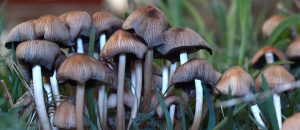When considering memory in relation to nature, trees often come to mind. The rings inside each tree tell us exactly how long it provided the precious oxygen we need to survive. We connect trees to life itself. It’s hard to imagine something older or more deeply connected to nature. However, long before we had trees and breathing life forms, we had mycelium. Not to be confused with the beautiful and sometimes terrifying fungi that it produces, mycelium incorporates the massive interconnected mycorrhizal system beneath the soil, under almost every step we take.
Did you know that animal and fungal kingdoms sprout from the same evolutionary branch, sharing our last common ancestor roughly 1 billion years ago? The wisdom of a billion years has evolved mycelium into a vital agent in the circle of life. Our distant cousin, still at work in aiding our co-survival, has long played a role in creating the world we see today. First documented in science in the late 90s by Canadian forestry ecologist, Dr. Suzanne Simard, mycelium networks play a key role in breaking down and storing essential minerals (like water, carbon, nitrogen, and sugars) and providing transport for these resources to trees through its numerous threads that are interwoven with their roots, (kind of like the forests own world wide web or “woodwide web” as dubbed by German forester Peter Wohlleben). Traveling through the roots of the trees to which it attaches itself, mycelium provides them with sustenance, information, and a pathway for connection to neighboring trees that they need to grow and thrive. We know now that this massive system is more complex than the human brain and fosters something many of us never considered possible in plants and trees before: kin recognition.
Mother trees can send signals of communication to their seedlings from miles and miles away with the use of the mycelium that connects them. The mother can send nutrients to its babies from miles away. They can even sense danger threatening their kin and send life sustaining nutrients or encourage migration to safer locations. Mycelium represents the kinds of natural mutual aid processes that have pushed evolution forward for billions of years. An amazing survival method and system of knowledge that holds memory for future generations.
Today, it seems humanity has become shallow, with an inability to understand the organisms that sustain our surroundings. Our wildlife, our food and water sources, and even our waste, all rely on mycelium. In addition, studies now show that this remarkable being also has the ability to help mitigate some of the harms we’ve caused the plant through the absorption of oil from spills and radiation contamination. However, it’s still often overlooked in the conversations surrounding environmental conservation.
We commonly advise someone under stress to engage with nature by touching grass or hugging a tree, but we rarely mention the intricate system just below us that artfully connects nature on such a profound level. Next time you need some outdoor therapy, I encourage you to dig deeper. Plant your hands in the soil, and connect with one of all our great true mothers, mycelium.



